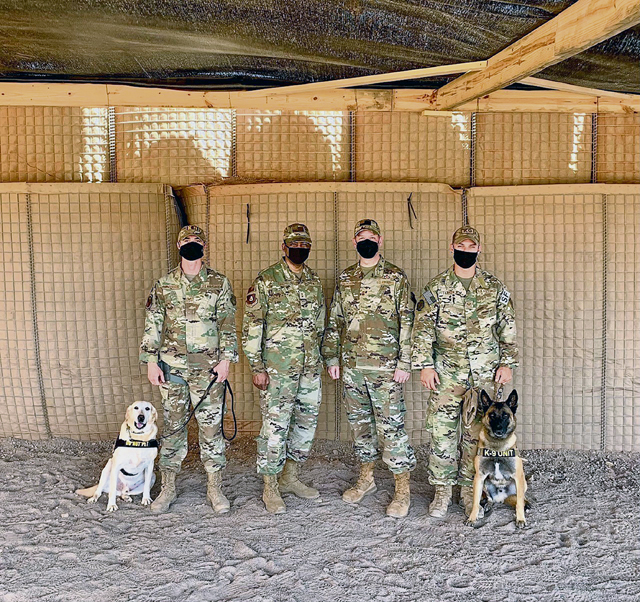Service members are usually deployed overseas at least once during their enlistment. They work in a remote location for months at a time, sometimes withstanding harsh environments. But, there are also 4-legged service members who deploy as well, and those are the fearsome military working dogs.

Staff Sergeants Dakota Farrow and Patrick Saddoris, 726th Expeditionary Air Base squadron military working dog handlers, have taken the initiative to protect Chabelley Airfield in Djibouti. Along with them are their furry coworkers, MWDs Max and Benny. Farrow and his MWD, Max, are deployed from the 56th Security Forces Squadron at Luke AFB, Arizona, while Saddoris and Benny are from the 9th SFS at Beale AFB, California.
Even though they do not come from the same home unit, the mission and camaraderie have improved and sustained their time at Chabelley Airfield.
“We are a part of a detachment, so we work closely with the Army,” said Saddoris. “Our primary focus here is base defense, and we are thrilled to have been able to accomplish as much as we have in such a short amount of time.”
One of the biggest accomplishments for the SFS unit was establishing a brand new MWD compound prior to being located out of a pop-up tent for two months.
“Having a secured compound greatly enables our ability to train and advance our MWDs,” said Farrow. “It’s nice having a secured area where people cannot enter and possibly get hurt; this is essential towards the mission.”
With help from the 776th Civil Engineering Squadron, the MWD compound became a reality within a span of three months.
“To create a compound there are certain requirements and we have to follow regulations,” said Saddoris. “So the communication factor with the 776th CES was huge. We told them what we needed and they made it happen.”
Working almost every day in a deployed environment can be challenging for many, but the MWD compound really allowed the handlers and their K-9s to support the mission.
“The compound enables MWD teams to live on station for extended periods of time,” said Farrow. “Additionally, the compound provides a safe and secure place for the dogs to stay away from people and stray animals.”
Additionally, while at Chabelley, Farrow and Saddoris were able to train with the Army, Navy, and Marine MWD units. This allowed them to maintain their training and lethal capabilities with the K-9s.
“It is always great for the MWD’s to work and train in new and unfamiliar places,” said Saddoris. “Getting the opportunity to work with different branches and agencies does nothing but add more knowledge and skills to our toolbox.”
This MWD unit established a milestone, and created a major impact for not only Chabelley, but also for future MWD members who take their place.
“We started with literally nothing, and it’s been challenging because not only did we have to work a normal shift, but we helped create this new compound as well,” said Saddoris. “Every.day has been a grind and we work our tails off and at the end it’s rewarding. We compared this from where we started and where it’s at now and it’s only going to get better. We’re both going to look back at this and appreciate the time with our dogs, appreciate the challenge and take ownership as a ‘we did this’ project.”


